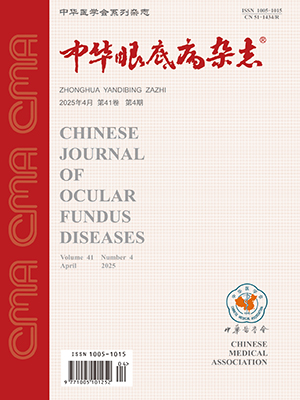| 1. |
Lina G, Xuemin Q, Qinmei W, et al. Vision-related quality of life, metamorphopsia, and stereopsis after successful surgery for rhegmatogenous retinal detachment[J]. Eye (Lond), 2016, 30(1): 40-45. DOI: 10.1038/eye.2015.171.
|
| 2. |
Park DH, Choi KS, Sun HJ, et a1. Factors associated with visual outcome after macula-off rhegmatogenous retinal detachment surgery[J]. Retina, 2018, 38(1): 137-147. DOI: 10.1097/IAE.0000000000001512.
|
| 3. |
Delolme MP, Dugas B, Nicot F, et al. Anatomical and functional macular changes after rhegmatogenous retinal detachment with macula off[J]. Am J Ophthalmol, 2012, 153(1): 128-136. DOI: 10.1016/j.ajo.2011.06.010.
|
| 4. |
Karacorlu M, Sayman Muslubas I, Hocaoglu M, et a1. Correlation between morphological changes and functional outcomes of recent-onset macula-off rhegmatogenous retinal detachment: prognostic factors in rhegmatogenous retinal detachment[J]. Int Ophthalmol, 2018, 38(3): 1275-1283. DOI: 10.1007/s10792-017-0591-6.
|
| 5. |
SamaraWA, Say EA, Khoo CT, et al. Correlation of foveal avascular zone size with foveal morphology in normal eyes using optical coherence tomography angiography[J]. Retina, 2015, 35(11): 2188-2195. DOI: 10.1097/IAE.0000000000000847.
|
| 6. |
Sugahara M, Miyata M, Ishihara K, et al. Optical coherence tomography angiography to estimate retinal blood flow in eyes with retinitis pigmentosa[J/OL]. Sci Rep, 2017, 7: 46396[2017- 04-13].https://www.nature.com/articles/srep46396. DOI: 10.1038/srep46396.
|
| 7. |
Agemy SA, Scripsema NK, Shah CM, et al. Retinal vascular perfusion density mapping using optical coherence tomography angiography in normal and diabetic retinopathy patients[J]. Retina, 2015, 35(11): 2353-2363. DOI: 10.1097/IAE.0000000000000862.
|
| 8. |
禹海, 高明宏, 李颖, 等. 累及黄斑的孔源性视网膜脱离手术后黄斑下积液眼黄斑形态变化与视力预后的关系及其影响因素分析[J]. 中华眼底病杂志, 2013, 29(2): 136-141. DOI: 10.3760/cma.j.issn.1005-1015.2013.02.005.Yu H, Gao MH, Li Y, et al. Relationship between morphologic macular changes and visual outcome in eyes with persistent submacular fluid after surgery for macula-off rhegmatogenous retinal detachment and relevant factors of persistent submacular fluid[J]. Chin J Ocul Fundus Dis, 2013, 29(2): 136-141. DOI: 10.3760/cma.j.issn.1005-1015.2013.02.005.
|
| 9. |
陈钰虹, 朱鸿, 王泓. 孔源性视网膜脱离术后视功能恢复的影响因素[J]. 眼科新进展, 2018, 38(4): 396-400. DOI: 10.13389/j.cnki.rao.2018.0093.Chen YH, Zhu H, Wang H. Influencing factors for the recovery of visual function following rhegmatogenous retinal detachment repair[J]. Rec Adv Ophthalmol, 2018, 38(4): 396-400. DOI: 10.13389/j.cnki.rao.2018.0093.
|
| 10. |
Joe SG, Kim YJ, Chae JB, et a1. Structural recovery of the detached macula after retinal detachment repair as assessed by optical coherence tomography[J]. Korean J Ophthalmol, 2013, 27(3): 178-185. DOI: 10.3341/kjo.2013.27.3.178.
|
| 11. |
Hisatomi T, Sakamoto T, Goto Y, et al. Critical role of photoreceptor apoptosis in functional damage after retinal detachment[J]. Curr Eye Res, 2002, 24(3): 161-172. DOI: 10.1076/ceyr.24.3.161.8305.
|
| 12. |
Yu J, Jiang C, Wang X, et al. Macular perfusion in healthy Chinese: an optical coherence tomography angiogram study[J]. Invest Ophthalmol Vis Sci, 2015, 56(5): 3212-3217. DOI: 10.1167/iovs.14-16270.
|
| 13. |
Spaide RF, Klancnik JM, Cooney MJ. Retinal vascular layers imaged by fluorescein angiography and optical coherence tomography angiography[J]. JAMA Ophthalmol, 2015, 133(1): 45-50. DOI: 10.1001/jamaophthalmol.2014.3616.
|
| 14. |
Hwang TS, Jia Y, Gao SS, et al. Optical coherence tomography angiography features of diabetic retinopathy[J]. Retina, 2015, 35(11): 2371-2376. DOI: 10.1097/IAE.0000000000000716.
|
| 15. |
Uji A, Balasubramanian S, Lei J, et al. Choriocapillaris imaging using multiple en face optical coherence tomography angiography image averaging[J]. JAMA Ophthalmol, 2017, 135(11): 1197-1204. DOI: 10.1001/jamaophthalmol.2017.3904.
|
| 16. |
Woo JM, Yoon YS, Woo JE, et al. Foveal avascular zone area changes analyzed using OCT angiography after successful rhegmatogenous retinal detachment repair[J]. Curr Eye Res, 2018, 43(5): 674-678. DOI: 10.1080/02713683.2018.1437922.
|
| 17. |
Yoshikawa Y, Shoji T, Kanno J., et al Evaluation of microvascular changes in the macular area of eyes with rhegmatogenous retinal detachment without macular involvement using swept-source optical coherence tomography angiography[J]. Clin Ophthalmol, 2018, 12: 2059-2067. DOI: 10.2147/OPTH.S177933.
|
| 18. |
Yui N, Kunikata H, Aizawa N, et al. Optical coherence tomography angiography assessment of the macular capillary plexus after surgery for macula-off rhegmatogenous retinal detachment[J]. Graefe's Arch Clin Exp Ophthalmol, 2019, 257(1): 245-248. DOI: 10.1007/s00417-018-4133-3.
|




